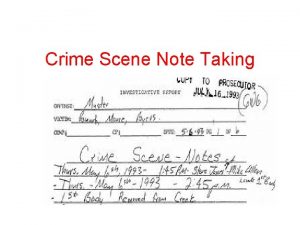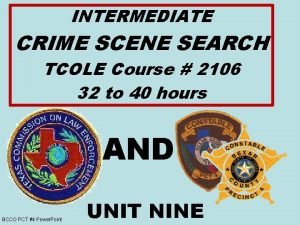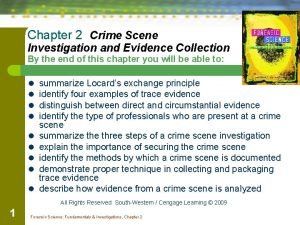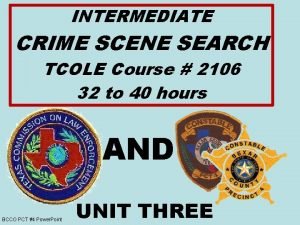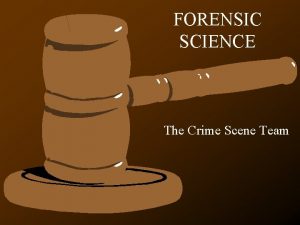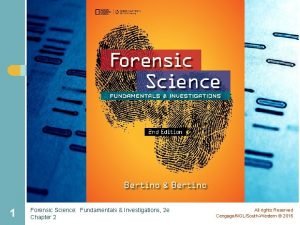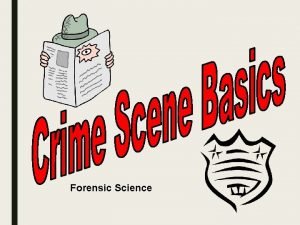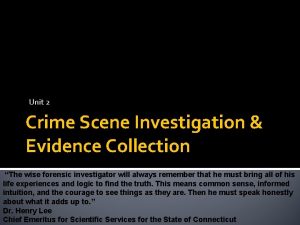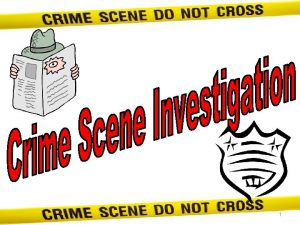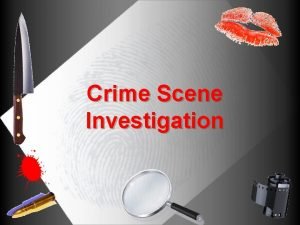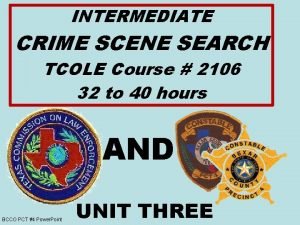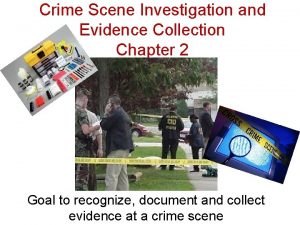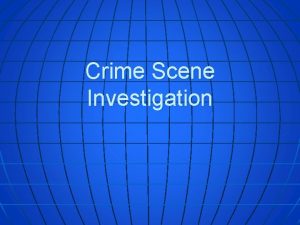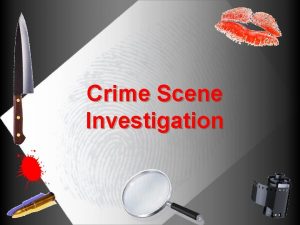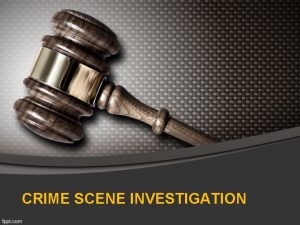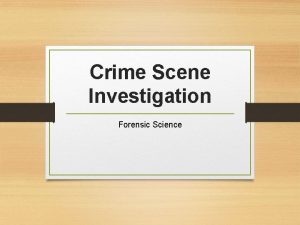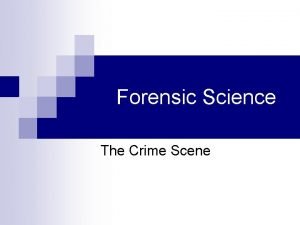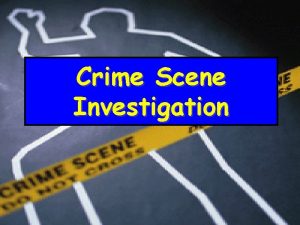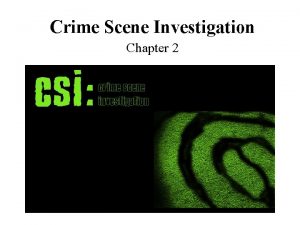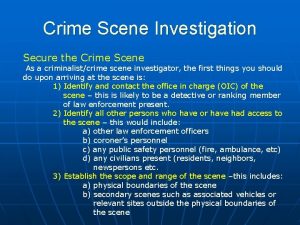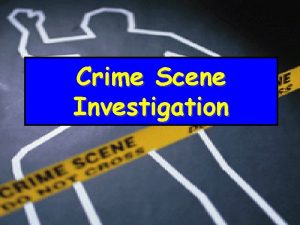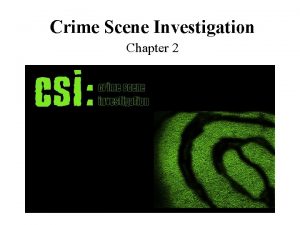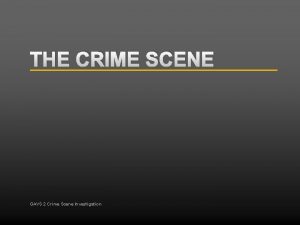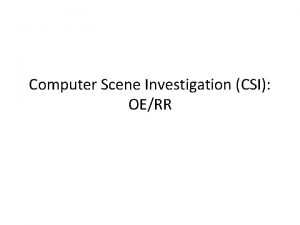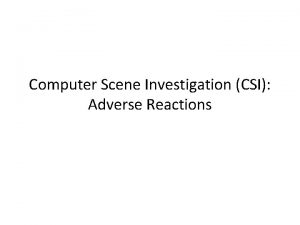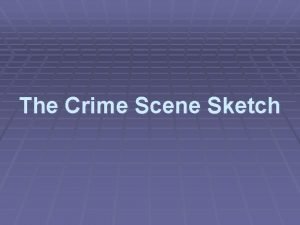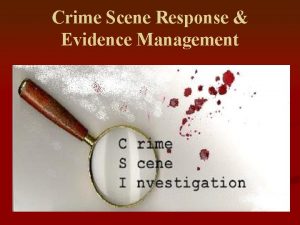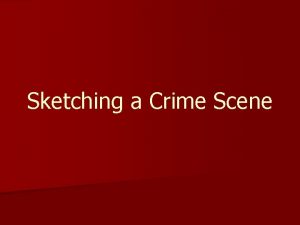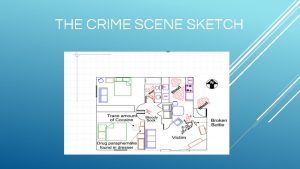WarmUp Crime Scene Investigation Crime Scene Team A






















- Slides: 22

Warm-Up

Crime Scene Investigation

Crime Scene Team § § A group of professional investigators, each trained in a variety of special disciplines. Team Members § § § First Police Officer on the scene Medics (if necessary) Investigator(s) Medical Examiner or Representative (if necessary, also called Coroner) Photographer and/or Field Evidence Technician Lab Experts pathologist serologist DNA expert toxicologist forensic odontologist forensic anthropologist forensic psychologist forensic entomologist firearm examiner bomb and arson expert document and handwriting experts fingerprint expert

Crime Personnel POLICE OFFICERS are typically the first to arrive at a crime scene. They are responsible for securing the scene so no evidence is destroyed and detaining persons of interest in the crime. The CSI UNIT documents the crime scene in detail and collects any physical evidence. The DISTRICT ATTORNEY may be present to help determine if any search warrants are required to proceed and obtains those warrants from a judge. The MEDICAL EXAMINER/CORONER (if a homicide) may or may not be present to determine a preliminary cause of death. SPECIALISTS (forensic entomologists, anthropologists, or psychologists) may be called in if the evidence requires expert analysis. DETECTIVES interview witnesses and consult with the CSI unit. They investigate the crime by following leads provided by witnesses and physical evidence. Source: http: //science. howstuffworks. com/csi. htm

7 S’s of Crime Scene Investigation 1. Securing the Scene – Responsibility of the first responder – Safety of everyone in vicinity is top priority – Evidence preservation is second priority 2. Separating the Witnesses – Avoids collusion (making a story match) – Questions that should be asked include:

Secure the Crime Scene

Questions for Witnesses A) When did the crime occur? B) Who called in the crime? C) Who is the victim? D) Can the perpetrator be identified? E) What did you see happen? F) Where were you when you observed the crime scene?

3. Scanning the Scene Determine if it is a primary or secondary scene • Primary crime scene – The original location of a crime or accident. • Secondary crime scene – An alternate location where additional evidence may be found. Where should photos be taken? Wear protective gear to prevent contamination of crime scene.

4. Seeing the Scene – CSI’s need to see the scene – Photos with and w/out rulers should be taken – Triangulation of stationary objects should be included for reference points

Photographing the Scene Take at least 3 shots: – Midrange shot: show the item is related to its surroundings – Close-up: bring out details of item • • Take 2 close-up shots if marking or measuring device is used One shot without device, one shot with device

Mark Evidence with Tents

5. Sketching the Scene – Position of body (if any) and any other evidence – Should be measured from 2 immovable landmarks – North should be labeled and a scale should be provided – Positions of furniture, doors (inside), shrubs, trees (outside) should be included

6. Searching for Evidence – Spiral, grid, linear or quadrant patterns should be used 7. Securing and Collecting Evidence – Physical evidence must be packaged and collected before time and weather can alter it – The Golden Hour – the window of opportunity to collect time-sensitive information or evidence

Packaging Evidence Bindle or Drugests Fold: folded paper used to hold trace evidence 1. Crease a clean paper and place the evidence in the X position (as shown above). 2. Fold in the left and right sides, and then fold in the top and bottom. 3. Put the bindle into a plastic or paper evidence bag affixing a seal over the opening. 4. Write your name on the seal.

Packaging Evidence • Proper packaging, sealing and labeling is vital – Liquid/Arson remains - airtight/unbreakable containers – Biological evidence - breathable containers so it can dry out – Dry item - bindle plastic or paper container • Must include a evidence log and chain of custody

Chain of Custody • Essential to maintain in order to present credible evidence in court, a chain of custody log is essential. • Original collector: bags evidence properly, labels it properly, seals it and signs the sealed edge. • Next person to receive evidence signs that they received it (lab technician for example); lab tech opens sealed container at a location other than the sealed edge; after examination, tech repackages , signs log and reseals with new tape/signature.

Labeling Evidence for Chain of Custody • Containers should be sealed with tamper proof tape, and dated and initialed • Each package should contain – Date, time, and location – Case number – Agency and collector’s name – Victim’s name(s) – Description of contents • Never package two items from two different sources or locations 17

Evidence Label – Indicates every person who has handled the evidence – Log must be attached to evidence packaging

Evidence Log – Case number – Item inventory number – Description of evidence – Name of suspect – Name of victim – Date/time of recovery – Signature of person recovering the evidence – Signature of any witnesses present during collection

Evidence Analysis • Done in forensic labs – the largest is the FBI crime lab • Forensic lab technicians are specialists – unlike what you see on tv • Results sent to lead detective who then attempts to reconstruct the crime scene

Investigating the Evidence Drug Chemistry – Determines the presence of controlled substances and the identification of marijuana Trace Chemistry - Identification and comparison of materials from fires, explosions, paints, and glass. Microscopy – Microscopic identification and comparison of evidence, such as hairs, fibers, woods, soils, building materials, insulation and other materials. Biology/DNA – Analysis of body fluids and dried stains such as blood, semen, and saliva. Toxicology – Tests body fluids and tissues to determine the presence of drugs and poisons. Latent Prints - Identification and comparison of fingerprints or other hidden impressions from sources like feet, shoes, ears, lips or the tread on vehicle tires. Ballistics (Firearms) – Study of bullets and ammunition through the comparison of fired bullets, cartridges, guns, and gunpowder patterns on people and objects. Toolmarks – Examines marks left by tools on objects at a crime scene or on a victim, such as a hammer used to break a door or a screwdriver used to pick a lock. Questioned Documents - Examination of documents to compare handwriting, ink, paper, writing instruments, printers, and other characteristics that would help to identify its origin.

What evidence would you collect and how?
 Note taking crime scene investigation
Note taking crime scene investigation 2106 crime scene investigation
2106 crime scene investigation Locard exchange principle
Locard exchange principle Tcole 2106 course
Tcole 2106 course 7 s's of crime scene investigation
7 s's of crime scene investigation Corpus delicti
Corpus delicti The seven s's of crime scene investigation definition
The seven s's of crime scene investigation definition Forensic science vocabulary
Forensic science vocabulary Crime scene investigation background
Crime scene investigation background The seven s's
The seven s's Intermediate crime scene investigation texas
Intermediate crime scene investigation texas The term encompasses all objects
The term encompasses all objects What are the 5 steps in crime scene investigation
What are the 5 steps in crime scene investigation Intermediate crime scene investigation tcole
Intermediate crime scene investigation tcole While the csi team is searching the crime scene, _____.
While the csi team is searching the crime scene, _____. Pathos story
Pathos story Gmass warmup
Gmass warmup Multiplying exponents
Multiplying exponents Tinman endurance coaching
Tinman endurance coaching Status vs class
Status vs class Java warmup
Java warmup Warmup ratio
Warmup ratio 65 mins
65 mins
